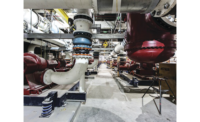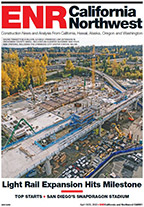Health care construction also is cresting in California. DPR Construction, Redwood City, started work in November on the $510-million Lucile Packard Children's Hospital in Palo Alto. Crews are installing 2,200 auger-cast piles to support the massive eight-level structure, says George Hurley, DPR project executive.
Just to the northwest, the $164-million Palo Alto Medical Foundation San Carlos Center is taking shape, another 2012 start for Skanska USA. "The health care market has been a significant market sector for us, and we expect the trend to continue," says Bob Babitsky, co-chief operating officer. He says that as a result of the 2010 Affordable Care Act, "we expect to see changes, but there will still be pent-up demand, given the national demographics."
Phoenix-based Kitchell broke ground in La Jolla on the $700-million University of California, San Diego Jacobs Medical Center. Kitchell used an unusual project management method, in which a board of directors—including owner, contractor and design and subcontractor representatives—oversees the design and construction progress of teams working on each main scope of work. "While this may appear complicated on paper, in practice it is quite efficient and a dramatic departure from traditional management processes," says Mike Wolfe, project director. "Leadership is totally integrated."
All this work is sparking a renewed sense of optimism among construction firms in California. "In the Bay Area, I would cautiously say that we are nearly in a boom climate," says DPR's Hurley.
But success brings new challenges. For example, contractors are concerned that there won't be enough workers for all of the hospital, college campus and office projects coming down the pipeline in 2014 and beyond, Hurley says.
Solar energy was one of the few sectors to decline last year. Solar held the top five ENR California starts in 2011, but only one solar job—the $520-million Catalina Solar Project—made the 2012 list. "California utilities are demonstrating a preference for smaller solar projects as opposed to the megaprojects we've seen developed and start construction the past few years," says Alan Bernheimer, public relations director with First Solar's San Francisco office. Projects in the 20-MW to 100-MW range now are more common, partly due to transmission constraints, but also because California utilities already have fulfilled most of their contractual obligations for the state's 33% renewable-energy requirement by 2020, he adds.


















Post a comment to this article
Report Abusive Comment